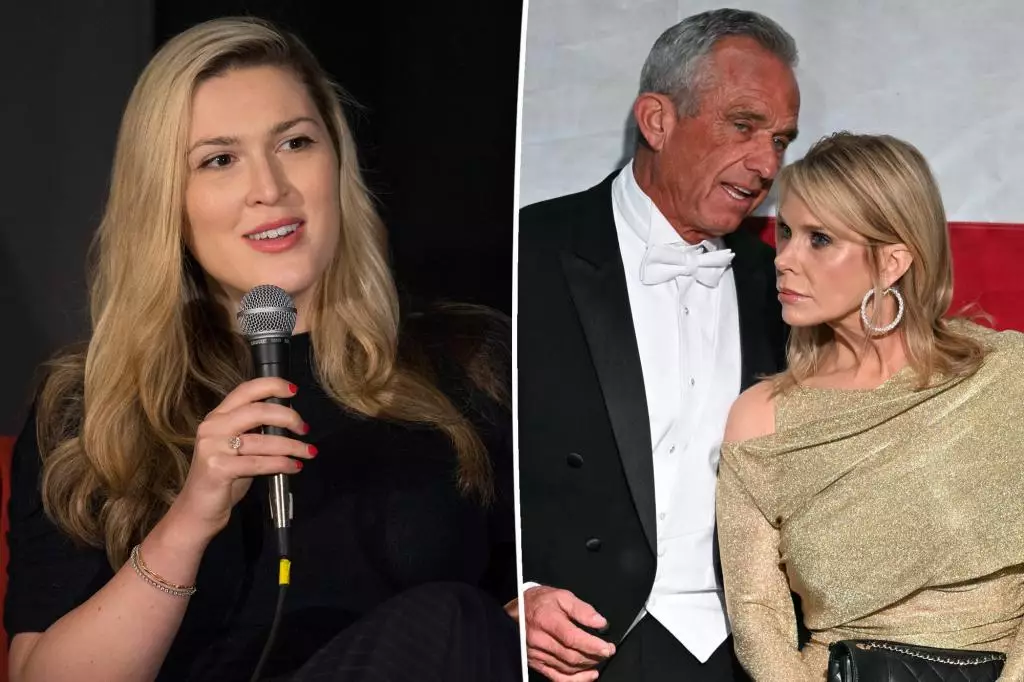The world of journalism often intertwines with the personal lives of reporters, sometimes leading to tumultuous public scrutiny. Olivia Nuzzi, a prominent writer for New York Magazine, recently found herself at the center of a significant scandal involving Robert F. Kennedy Jr. Despite the upheaval in her personal life, Nuzzi made a notable public appearance in Los Angeles, showcasing a blend of style and confidence amid controversy.
Nuzzi’s latest public appearance occurred at a fashion event hosted by Argent, a renowned brand often favored by celebrities. She was seen donning a sleek black double-breasted suit that highlighted her fashion sense and personal style. Attending alongside other influential figures in the film and media industries, including Kate Mara and Ava DuVernay, Nuzzi still managed to command attention. Reportedly, she radiated confidence, with subtle yet chic details like red nail polish and a glimpse of a black bra contributing to her striking look. Such an appearance marks a significant moment of reemergence following the scandal that has overshadowed her professional life.
To many observers, it might seem surprising that Nuzzi could present herself so composed in the midst of public scrutiny. However, her presence at a celebrated venue like République suggests a strategic choice to regain visibility following her controversies, possibly marking a crucial step in her personal and professional recovery.
Nuzzi’s public storyline is complicated by an ongoing legal struggle. Following her breakup with fellow journalist Ryan Lizza, she accused him of blackmail, a serious allegation that has added tension to their tumultuous relationship. At the core of their dispute is Lizza’s assertion that Nuzzi engaged in an extramarital affair with RFK Jr., a situation further complicated by both parties swapping accusations of misconduct.
Lizza recently filed court documents claiming to have discovered Nuzzi’s year-long affair with Kennedy, describing it as “toxic” and fraught with emotional turmoil. Nuzzi, on her end, has countered by accusing Lizza of threatening to damage her reputation. This tit-for-tat has drawn significant media attention, placing both reporters under the microscope.
Kennedy has also entered the fray, denying any wrongdoing while facing speculation about his personal life. Compounding matters, he has publicly supported former President Donald Trump, creating an even more complex narrative around his already controversial figure. The intricate web of lies, allegations, and defenses complicates what should be a straightforward recounting of events, illustrating how intertwined personal and professional lives can become for public figures.
Nuzzi’s choice to attend a high-profile fashion event amidst her personal turmoil raises questions about the role of public image in contemporary journalism. When embroiled in controversy, maintaining a visible public persona can be interpreted in various ways—either as an attempt to reclaim agency or as a potential distraction from unsavory situations.
Attending an event associated with a well-respected brand like Argent, alongside powerful women in the industry, can allow Nuzzi to create alliances and reinforce her standing in the fashion and media space. Nuzzi has previously collaborated with Argent, even posting about it on social media to frame herself as someone whose fashion choices are both relatable and aspirational. This dichotomy between professional credibility and personal controversy showcases the challenges modern journalists face: the necessity to be present and connected while navigating very public scandals.
The unfolding drama surrounding Nuzzi, Lizza, and Kennedy reflects broader themes within media culture today. Journalists often find themselves at the center of stories they cover, which raises ethical dilemmas and complicates the line between reporting and being reported on. In an age where information is rapidly disseminated and scrutinized, maintaining control over one’s narrative becomes essential.
As Nuzzi continues to navigate her complicated personal history, her public appearances may serve as strategic endeavors to counteract the negative perceptions that have arisen. The dense narrative surrounding her—rife with accusations and counterclaims—reminds us all of the fragility of reputation in the public eye. Ultimately, the intersection of personal choices and professional lives can forge an inescapable narrative that defines how individuals are viewed by society.
In essence, Nuzzi’s journey reflects resilience and the effort to reclaim one’s narrative amidst chaos. As she moves forward, her ability to balance the demands of public perception with personal integrity will be crucial to her career and reputation. The ongoing saga raises critical questions about accountability, personal ethics, and the evolving landscape of journalistic integrity in the modern age.

Leave a Reply